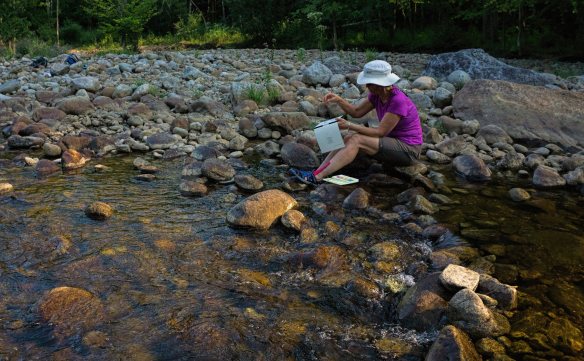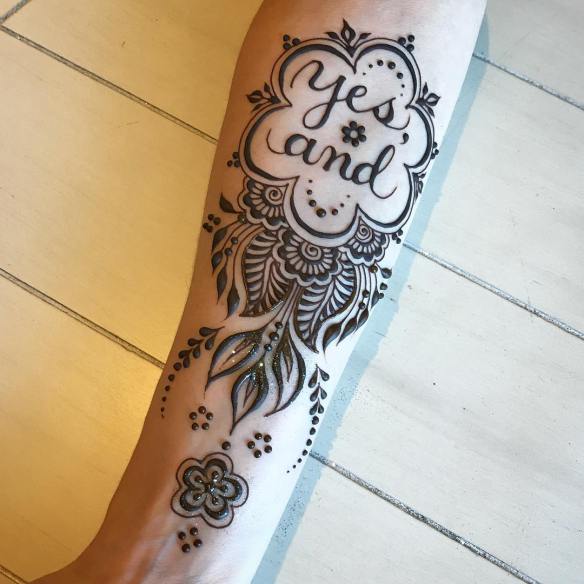Amazing how much past learning, reading and conversation is coming to mind and informing this post. Thinking of a title for the post I considered Creative Arts or the Art of Creativity. Almost immediately, Uri Alon’s TEDtalk, and his use of the phrase “Yes, and …” popped into my mind. Nope, can’t be or, must be and. Hence the blog post title — Creative Arts and the Art of Creativity. Both are valuable and important, and I don’t want to suggest anything different in my title.
Will Burns wrote an article entitled Should Education Focus Less on the Creative Arts, More on the Art of Creativity? I loved his conversation with his son about creativity.
Just this morning I asked my son who just graduated high school to name the most creative person in his class and why he thought so. He thought about it and said, “I think it would be Cassidy Davis (changed name) because she is incredibly good at drawing people’s faces.” My son seemed to equate “creativity” with a talent. But, interestingly, he went on to say, “Yeah, she does these drawings of people but then puts them into these scenes that are totally trippy and surreal.” (Will Burns, Forbes, August 7, 2017 @ 01:26 PM)
Burns exclaimed “Now that is creativity.”
I chuckled when I read that. I agree, that does sound creative. Cassidy moved beyond her talent to produce “good drawings” and interjected some creativity — placing the expertly drawn faces in fantastical scenes, created in her imagination and translated onto the page through her fingers.
Considering the definition of creativity, and whether or not something was creative, brings me back to the many awesome conversations with Karl during and after my MA Creative Thinking work at UCLan.
What exactly is creativity? Is it the same as talent? Is it connected to talent? Can we teach it? How? (And, a zillion other questions.) For now, the important conversation centers on the definition of creativity.
Creativity is new and useful or appropriate. So yes, when I read Burn’s son’s description I thought “Wow, that sounds creative, and quite cool.” But, if Cassidy’s drawings were not appropriate to the task at hand, they would not be creative. Talented and unique, perhaps, but not creative. Interesting, right?
I thought of this the other day as I did some plein air painting in the Adirondacks.
After hiking in, I settled myself, and my watercolors, on rocks in the river. I love this spot on the Ausable River, and I wanted to enjoy the river, the air and the moment. My artistic/creative goal was to capture the movement and spirit of the water, while incorporating a bit of the color mixing I had done at home.

As I sat — breathing and thinking in this great space — I was splashed repeatedly by the river as it flowed by me. Through those splashes, I felt the river asking for my attention, gently nudging me to capture its essence by actually using it in my painting.
I put aside my waterbrush and began gathering water from the river. Slowly, splashes, drips, and then rivers of water, formed on my paper. Grabbing my brush, I wet my paints with the river water. The many colors of nature began to form on the page as the paints moved through the water. Sometimes they glided past one another without mixing, and other times they crashed into one another, swirling into ribbons and pools of new colors.
It was a fascinating and enjoyable process. I noticed the many things I could, and could not control in the process. Much like I must do when walking on the river, I accepted and relaxed – respecting the power but not fearing it.

I am not sure anyone would consider me a great watercolor talent after seeing this painting. I am growing in my knowledge, skill, understanding and talent. But, a great talent? Not yet.
But, is it creative? Yes — it is a new idea that is appropriate to my task and goal.
I wasn’t sure I had achieved the essence of the river until I tried to photograph the painting. It looked best when it sat amidst the rocks. Just like the water around it, it gathered strength, grace, beauty and meaning from the rocks.
Back to one of my original questions. Is creativity the same as talent? No.
Is it then, completely different, completely removed from creativity? Again, no.
Thesaurus.com includes ability as a synonym for talent. They define it as “natural or acquired power” in something.
I am, for the first time, having this insight about talent and creativity. Perhaps talent and creativity are related just the way talent and playing the piano, talent and doing math, or talent and fencing are related. As my skills grow, my talent grows. As my understanding grows, my talent grows. As I practice, try, fail, learn, succeed — my talent grows. The talent can be in relationship to a plethora of different things — including creativity.
And, as my creativity grows – as a thinker in general, or in a specific arena – my talent, so to speak, always grows. Think of jazz musicians, scientists developing life saving drugs, mathematicians proposing or solving incredible problems, poets writing exquisite poems — their talent feeds their creativity, which in turn feeds their talent! It is a beautiful feedback loop.
Neither talent nor creativity are fixed abilities. We all have the ability to be talented and creative. Some may be more innately talented or creative, and levels of talent and creativity vary. But, and this is an incredibly important thing for everyone — perhaps especially, parents, teachers and young people — to hear, with learning and practice, everyone can grow in talent and creativity.
This leads me back to Mr. Burn’s article Should Education Focus Less on the Creative Arts, More on the Art of Creativity? and back to my “Yes, and …” from the beginning of this post. I love Burn’s thoughts in his article about the importance of creativity, and of a teacher with an MA Creative Thinking to help others navigate. However, I lean towards Uri Alon’s idea — Yes, and.
Yes, creative arts, AND, yes, ABSOLUTELY, POSITIVELY the art of creativity.
I think, perhaps, Mr. Burn’s would agree with that statement. But, that’s for another post!






